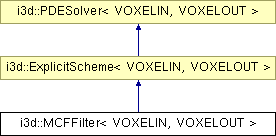i3d::MCFFilter< VOXELIN, VOXELOUT > Class Template Reference
[Image preprocessing filters]
This class implements together with class MCFFilterFunction the Curvature Flow anisotropic diffusion filter, which was published by Alvarez, Lions and Morel. As the other anisotropic filters, this filter smooths the image in the relatively continuos region and do not smooth the significante edges. Moreover it generates the so called morphological scaale space. In the typical output image is suppresed the noise and the edges remain sharp and well localised. The diffused image is the solution of the equation  . The particular implemantion is based on explicit finite difference solver and therefore there exist some limitations to the time step.
More...
. The particular implemantion is based on explicit finite difference solver and therefore there exist some limitations to the time step.
More...
#include <LevelSet.h>
Inheritance diagram for i3d::MCFFilter< VOXELIN, VOXELOUT >:

Detailed Description
template<class VOXELIN, class VOXELOUT>
class i3d::MCFFilter< VOXELIN, VOXELOUT >
This class implements together with class MCFFilterFunction the Curvature Flow anisotropic diffusion filter, which was published by Alvarez, Lions and Morel. As the other anisotropic filters, this filter smooths the image in the relatively continuos region and do not smooth the significante edges. Moreover it generates the so called morphological scaale space. In the typical output image is suppresed the noise and the edges remain sharp and well localised. The diffused image is the solution of the equation  . The particular implemantion is based on explicit finite difference solver and therefore there exist some limitations to the time step.
. The particular implemantion is based on explicit finite difference solver and therefore there exist some limitations to the time step.
The image is smoothed by finding solution of partial differential equation
![\[ u_t = \mathrm{div} ( \nabla u / |\nabla u|) |\nabla u| \]](form_20.png)
where  is the input image (boundary condition of the PDE). In the context of level set equations, the above equation can be written as
is the input image (boundary condition of the PDE). In the context of level set equations, the above equation can be written as
![\[ u_t = \kappa |\nabla u| \]](form_22.png)
The idea of this equation is to smooth the image in regions with high curvature (i.e. noise) and do not diffuse the image near significant edges. The advantage of the filter is that there are no parameters to adjust the behaviour of the filter. The only value, which can the user adjust is the stopping time (time step + number of iterations) of the diffusion. If we we diffuse the image to the infinity we get the constantly valued grey image.
The typical setting of coefficients for biomedical images produced in LOM should be:
A few of iterations (1 to 10) should be sufficient to to smooth the image. due to the limitation of used explicit numerical discretisation should be the time step lower than 0.25 for 2D images and lower than 0.125 for 3D images (See also the example code). If there is no time step set, the possible largest is set automatically.
The numerical scheme which finds the solution of the equation is implemented in ExplicitScheme class. This class inherits the solution.
The implementation of this class is based on the chapter 16 from book
J. A. Sethian, Level Set Methods and Fast Marching Methods , Cambridge University Press 1999.
Example code for using this filter:
.....
Image3d<GRAY8> i;
Image3d<float> fimg;
i.ReadImage('input.tif'); // read input image
MCFFilter<GRAY8,float> CF(i,fimg); // instantiate the filter (the two parameters are the input and the output image)
CF.SetMaximumNumberOfIterations(3); // Set the number of iterations to 2
CF.SetSpacing(1.0,1.0,2.0); // Set the spacing of spatial discretisation to 1,1,2
CF.Execute(); // Perform the work of the filter
FloatToGray8NoWeight(fimg,i); //Convert the output float image to gray8 image
i.SaveImage('output.tif'); // save the output of the filter
......
- Date:
- 2005
The documentation for this class was generated from the following files:
- LevelSet.h
- LevelSet.cc

